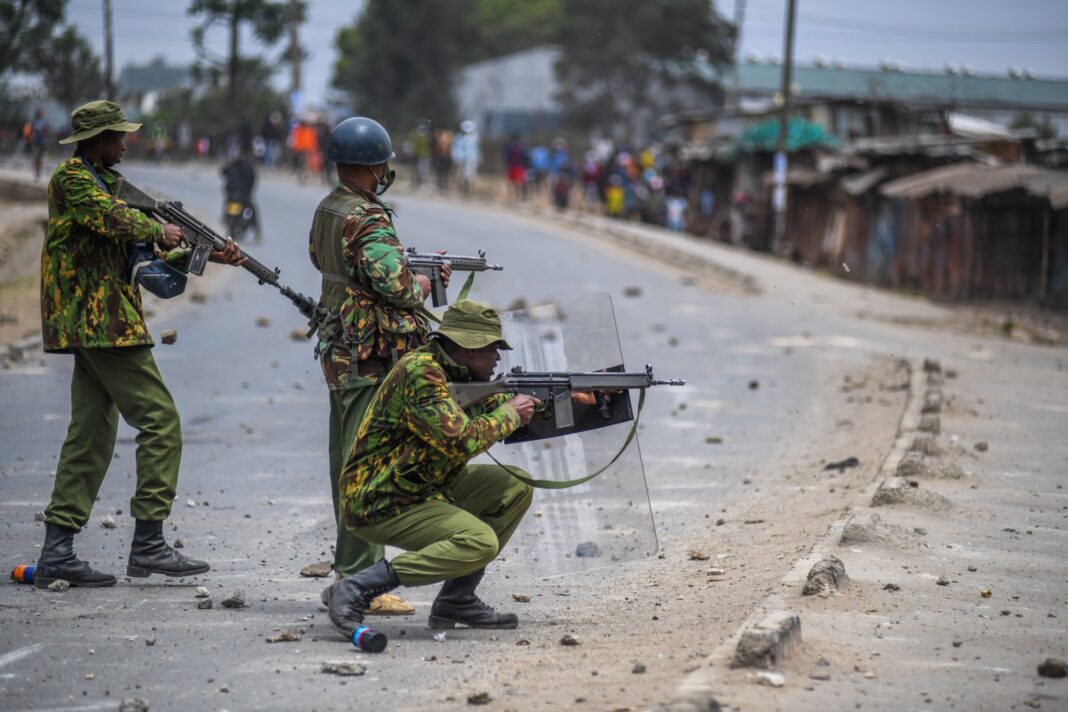Kenya has recently faced extensive protests against the cost of living. The costs have been worsened by President William Ruto’s new financial laws. For instance, new regulations include tax hikes and a doubling of Value Added Tax (VAT) on petroleum products (source). Kenya has the right to peaceful protest enshrined in the constitution. Opposition parties have thus organised a series of protests. Kenya is also facing a resurgence of Al-Shabaab violence on its northern border with Somalia. This is contributing to instability in Kenya. The country has not suffered a high-profile jihadist terror attack since 2019. However, recently, small-scale attacks have occurred raising fears that Al-Shabaab is turning its attention to Kenya (source).
Key Judgement 1: It is unlikely that President Ruto will repeal the new financial legislation, resulting in continued protests and instability.
Key Judgement 2: It is likely that the Kenyan police will continue to use force against protesters and political oppositions, further increasing distrust from the public.
Key Judgement 3: It is likely that Kenya will face attacks from Al-Shabaab across its northern border resulting from limited border security and Kenyan involvement in the offensive against the group.
KJ-1: It is unlikely that President Ruto will repeal the new financial legislation, resulting in continued protests and instability in Kenya.
a. President William Ruto has not successfully tackled inflation and has instead raised taxes (source).
b. The government has also introduced levies on fuel and housing (source).
c. Furthermore, the International Monetary Fund (IMF) has stated that the new financial laws are a crucial step towards reducing Kenya’s debt vulnerabilities (source).
d. Kenya’s shilling is expected to weaken further in the coming weeks. This is due to a demand for dollars from the energy sector (source).
e. Authorities arrested seven elected leaders, along with two associates, during recent protests (source).
KJ-2: It is likely that the Kenya police will continue to use force against protesters and political oppositions, further increasing instability and distrust from the public.
a. Human Rights Organisations have accused Kenyan police of using excessive force against those protesting the government’s tax hikes (source).
b. The UN has issued a report stating that Kenyan police allegedly killed up to 23 people at the beginning of July in clashes during protests (source).
c. Reports also suggest that police fired tear gas in the capital city of Nairobi against protesters fuelling political instability in Kenya (source).
d. Authorities detained MP Babu Owino without charge for three days and deprived him of food and water (source). Owino had previously condemned the policy and the government for using brute force against anti-government protests.
e. A police official told the Associated Press that they were not to report any deaths in the demonstrations (source). Executive Director of the Medico-Legal Unit Watchdog, Peter Kiama, claims that this is an indication that police are acting in the interests of the executive, not the public.
f. Significantly, the majority of Kenyans already view the police with scepticism (source).
KJ-3: It is likely that Kenya will face attacks from Al-Shabaab across its northern border resulting from limited border security and Kenyan involvement in the offensive against the group.
a. In June 2023, Al-Shabaab killed two dozen people in Northern Kenya (source). The attack consisted of roadside bombings and beheadings.
b. Africa Specialist at Science Po University, Roland Marchal, says that disorganisation and instability at the border between Kenya and Somalia will likely lead to further attacks (source).
c. Nicolas Delaunay, International Crisis Group Director for East and Southern Africa has stated that the recent attacks are a way for Al-Shabaab to demonstrate that they are still a force to be reckoned with (source). He also claims that it could be a warning against Kenya. Kenya has agreed to participate in the Somali government’s offensive against Al-Shabaab.
d. Kenya’s Lamu county struggles with poor infrastructure and heavy rains which makes it difficult for security patrols to operate (source).
Analytical Summary
We have high confidence in KJ-1 and KJ-2 and moderate confidence in KJ-3. Our analysis is primarily based on statements from security experts, local news reporting, and inter-governmental organisation reporting. For KJ-1, we are assuming that President Ruto will fail to consider the grievances being brought by the public and by opposition groups. Were this assumption proven to be incorrect, we would likely see increased dialogue between Ruto and his opposition counterparts regarding financial matters. Insight into President Ruto’s internal communications would reduce uncertainty.
Intelligence cut-off date: August 11 2023

